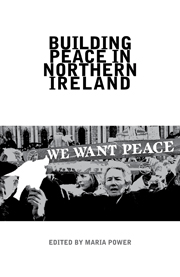Book contents
- Frontmatter
- Contents
- Acknowledgements
- Contributors
- 1 Introduction: Peacebuilding in Northern Ireland
- 2 Understanding the Role of Non-aligned Civil Society in Peacebuilding in Northern Ireland: Towards a Fresh Approach
- 3 The Role of Civil Society in Promoting Peace in Northern Ireland
- 4 The Contribution of Integrated Schools to Peacebuilding in Northern Ireland
- 5 Providing a Prophetic Voice? Churches and Peacebuilding, 1968–2005
- 6 ‘Peace Women’, Gender and Peacebuilding in Northern Ireland: From Reconciliation and Political Inclusion to Human Rights and Human Security
- 7 Encumbered by Data: Understanding Politically Motivated Former Prisoners and the Transition to Peace in Northern Ireland
- 8 Loyalism and Peacebuilding in the 2000s
- 9 Civil Society, the State and Conflict Transformation in the Nationalist Community
- 10 Examining the Peacebuilding Policy Framework of the Irish and British Governments
- 11 Building Peace and Crossing Borders: The North/South Dimension of Reconciliation
- 12 Peace Dividends: The Role of External Aid in Peacebuilding
- Index
10 - Examining the Peacebuilding Policy Framework of the Irish and British Governments
- Frontmatter
- Contents
- Acknowledgements
- Contributors
- 1 Introduction: Peacebuilding in Northern Ireland
- 2 Understanding the Role of Non-aligned Civil Society in Peacebuilding in Northern Ireland: Towards a Fresh Approach
- 3 The Role of Civil Society in Promoting Peace in Northern Ireland
- 4 The Contribution of Integrated Schools to Peacebuilding in Northern Ireland
- 5 Providing a Prophetic Voice? Churches and Peacebuilding, 1968–2005
- 6 ‘Peace Women’, Gender and Peacebuilding in Northern Ireland: From Reconciliation and Political Inclusion to Human Rights and Human Security
- 7 Encumbered by Data: Understanding Politically Motivated Former Prisoners and the Transition to Peace in Northern Ireland
- 8 Loyalism and Peacebuilding in the 2000s
- 9 Civil Society, the State and Conflict Transformation in the Nationalist Community
- 10 Examining the Peacebuilding Policy Framework of the Irish and British Governments
- 11 Building Peace and Crossing Borders: The North/South Dimension of Reconciliation
- 12 Peace Dividends: The Role of External Aid in Peacebuilding
- Index
Summary
Since 1986 approximately €2.95 billion has been spent in Northern Ireland the Border Counties funding conflict transformation initiatives through the IFI, Peace I and its successor Peace II and the INTERREG I, II and IIIA programmes, largely through social and economic development. The IFI was set up in 1986 by the Irish and UK governments through the Anglo-Irish Agreement with the twin objectives of promoting social and economic advance and encouraging contact, dialogue and reconciliation between the two communities in Northern Ireland and on both sides of the Border. Funded by the United States, the EU, Canada, Australia and New Zealand, it formally ceased operations in 2010. Peace I was set up in the wake of the 1994 IRA and loyalist ceasefires to support peace and reconciliation in Northern Ireland and the Border Counties, largely through social and economic development activities. Funded by the EU and the Irish and British governments, it covered the period 1995–1999, with Peace II continuing this work from 2000–2004 and the Peace II Extension covering the period 2005–2006 (Peace III, covering the period 2007–2013, is currently underway). INTERREG was initially set up by the EU in 1991 to assist weaker internal border areas in dealing with the Single Market and has been restructured over the years with INTERREG III primarily concerned with promoting sustainable and integrated cross-border development.
- Type
- Chapter
- Information
- Building Peace in Northern Ireland , pp. 172 - 190Publisher: Liverpool University PressPrint publication year: 2011



